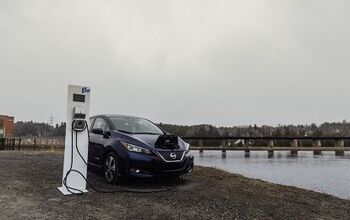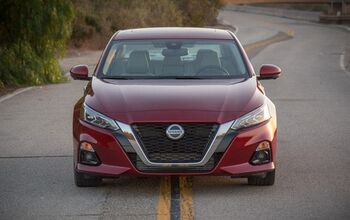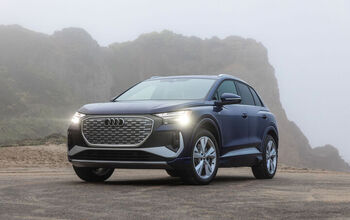2012 Nissan Leaf Review [Video]

Certain cars can’t accurately be judged on a choreographed press junket. Take a minivan for instance. To properly evaluate such a vehicle requires a road trip with a spouse and kids.
FAST FACTS |
1. Using the new MPG Equivalent rating, the Leaf gets 99 mpge with 106 city and 92 highway. 2. With an EPA rated 100-mile range, look for about 70 miles in real world driving. 3. 3. For an additional $2,000 a charge port can be fitted to most houses allowing a charge time of roughly 7 hours. A special Quick Charger can also be used allowing for an 80 percent charge in 30 minutes, although you’ll need the top trim SL to get the right port on the car. Using just a 120-volt outlet, charging takes over 20 hours. 4. Leaf models start at $35,200 or $37,350 for the SL trim, minus a $7,500 tax credit. |
Likewise, an electric car must be lived with in order to be judged. That said, I recently borrowed a Nissan Leaf for three days and set out to use it just as I would with any conventional internal combustion engine vehicle. That may sound simple enough for an urbanite, those for whom six miles is considered a commute, but for me it’s an 80 mile round trip.
And while Nissan may claim 100 miles as an EPA-rated ranged, they’ll also admit that the real-world distance is closer to 70 – just shy of the range I’d need to travel back and forth from work.
LEAF DOESN’T MEET “JUST IN CASE” CRITERIA
Understandably, almost no one in my situation would seriously look at purchasing an electric car with such a limited range. But being the curious sort, I wanted to know: How far has the technology come and could an electric car work for someone like me?
After all, most Americans buy cars for the just in case factor. As in, it has all-wheel drive just in case it snows, or it as a third row just in case they need to drive their kids and their kids’ friends to the mall. In short, these features are no different than a 400-hp V8 in a Mustang. It may only be used once a week, or even less, but that’s the reason they bought the car.
For the American car buyer, a 300-mile range and the ability to double it with a quick stop at a gas station has become the norm, and in order to achieve mainstream acceptance, EVs need to do the same.
An official product launch with such a car would have carefully planned routes with chase cars should I get stranded and a long list of phone numbers of PR folks to assist me should I get lost. Not this time. Upon picking up the car I was given a special trickle charger that plugs into a conventional 120-volt household outlet, as well as a phone number of an emergency towing company.
RANGE ANXIETY AN ADDED AND UNNECESSARY STRESS
As soon as I left the parking lot the range anxiety took hold, although to be honest it had actually started the week before when I confirmed the pickup day with Nissan. It was then that it hit me: I had calculated the distance to and from my house to the AutoGuide offices to see if it was possible, but the pickup location for the car was much further away. Nissan offered to drop the car off, but that would have been cheating, as I normally pick up Nissan pressers at the same depot.
A quick check on Google maps calmed by fears, slightly. The distance from the fleet center to my house on the other side of town was slightly less than 60 miles. So it should make it? Right?
Make it I did, though not without significant fretting, which began when I left the parking lot and became severe as I accelerated onto the highway. As I learned over the course of three days, electric cars are very much the opposite of gasoline ones when it comes to the type of driving that maximizes fuel economy.
Officially rated at 99 mpge (miles per gallon equivalent), the city rating is an incredible 106 mpg while the highway rating is 92. That may not sound significant, but when every mile counts, it is. Crawling along in gridlock the next day it was reassuring to see the mileage range number on the dash sit idle mile after mile. But on the highway the digits would often count down like the dying seconds on a scoreboard, a rather frightening distraction as I attempted to summon Jedi-like powers to slow the countdown to what I foresaw as my inevitable destination – stranded on the side of the road.
In fact, I became so paranoid of the quickly depleting energy supply that I switched off the climate control in order to conserve as much battery life as possible. As silly as that may sound, within the Leaf’s Carwings telematics system there’s a screen that will tell you how much range you can gain by doing just that. It’s not insignificant either, totaling three whole miles on this journey. A mild inconvenience on an ideal day, my worry of reaching home was so severe I did so even with the mercury sitting at the freezing point.
Nearing my house and off the highway the range reading ceased its recessionary stock market-like fall at 17 miles and my emotions switched from worry to a cocksure attitude as I decided to drop in to the grocery store – warming my now frozen toes in the process.
Arriving home I was confronted with the reality of not having a quick-charging station – something any Leaf owner would be sure to have installed for a cost of around $2,000. Nissan proudly proclaims a 7 hour charge time using a 240-volt outlet as well as a special quick charger than can boost the car’s battery to 80 percent in just 30 minutes. Using the supplied trickle-charger it takes over 20 hours, leaving me to wonder if I’d be able to make my morning commute on schedule.
LOTS OF TECH TO GEEK-OUT ON
While the car guy in me wants to discount an electric car as a fad, my inner car geek is fascinated by the incredibly new experience. Just a decade ago new technology only came to market in ultra expensive exotic cars and only to promote performance. Now cars like the Leaf and Prius are bringing revolutionary tech to a whole new segment of buyers.
Adding to the tech geekiness of the Leaf is the Carwings system, and the smartphone app associated with it. Nissan was kind enough to supply an iPhone with the car, with the app preloaded. With it you can check on the state of charge, showing the current range available and hours left until the battery is full. It will also allow you to schedule a charge time (ideal for targeting off-peak hours) or to turn on the car’s climate control system so it can warm up or cool down before you get there.
On the road, Carwings will let you know if your destination set in the navigation system is possible with the car’s current range, plus it can direct you to the nearest EV charging station.
As the sun set on my first day with the Leaf, the time left for a full charge was 10 hours. As I awoke the next day it informed me that with two hours left to go I currently had a 50-mile range. Not wanting to wait, I set off.
A discrepancy between the app and reality proved beneficial, with the car claiming a 75-mile range. Reassured, I had no issues making it to the office, and was thrilled to find the EV charging station nearby vacant. Of note, the location, just two blocks from work, was not listed on the Carwings system. Rather I found it through a simple Google search. Even better news, it was free – although the parking spot still cost $11.
On subsequent commutes my range anxiety decreased but never went away. The 7 hour charge port also helped give a more realistic idea of what an average Leaf buyer would experience, removing an added stress by having a car that’s capable of making a trip much more of the time.
AN OTHERWISE SOLID CAR
As for the rest of the car, it’s a solid machine and surprisingly normal – something Nissan went to great lengths to focus on, even making the electric motor look like a 4-cylinder engine. Our test car, a top trim SL model, also featured plenty of convenience features like a heated steering wheel and seats.
Surprisingly, the Leaf isn’t tiny, especially in height, with a roof that’s just a half-inch shorter than a MINI Countryman. It’s also reasonable quick despite just 107 hp and thanks to the immediacy with which electric torque (207 lb-ft) is delivered, it feels like a sports car compared to the Prius.
Driving the car isn’t odd, despite the lack of engine noise. There’s enough sound generated from the tires and the air passing by the car. Others will hear your coming too, thanks to an “Approaching Vehicle Sound for Pedestrians” system that essentially emits noise from a speaker in the front of the car at speeds below 19 mph.
THE VERDICT
Designed to work within an urban environment, the Leaf certainly succeeds. Beyond that, it’s possible to live with (an impressive feat all on its own), but far from ideal. To reach into the mainstream it needs either an all-day driving range, or a charge time equivalent to a gas station fill up. Let’s be honest, 7 hours is impressive, but if EVs are to catch on, even 7 minutes is too long.
While not a roadblock to EV success, there is another issue that needs to be pointed out and one that became relevant over the course of three days with the Leaf. While the cost to own is actually quite affordable (starting at $27,700 after a $7,500 government rebate), the cost to operate isn’t the “pennies a day” number that’s often quoted.
Nissan officially says a full charge is roughly $2.75, which sounds minimal, but if you require a significant charge twice a day, you could be looking at $4.00 a day in electricity, or as high as $5.50 – hardly insignificant. Now take the 50-mpg Prius. Drive it 80 miles a day as I do, using roughly 1.6 gallons of gas priced at $4.00 a gallon and the total cost is somewhere just north of $6.00. The difference? Hardly extreme. And the drawbacks of an electric car? Significant.
Related Reading
2012 Mitsubishi i Review
2011 Chevrolet Volt Review
2010 Toyota Prius Review
2012 Honda Civic Hybrid Review
2012 Nissan Leaf First Drive
LOVE IT
- An emissions free solution for more than just a few
- A very real car
- Cool technology
LEAVE IT
- Slow charge times
- Limited range
- Cost to operate hardly pennies a day
- Range anxiety an added and unnecessary stress

With AutoGuide from its launch, Colum previously acted as Editor-in-Chief of Modified Luxury & Exotics magazine where he became a certifiable car snob driving supercars like the Koenigsegg CCX and racing down the autobahn in anything over 500 hp. He has won numerous automotive journalism awards including the Best Video Journalism Award in 2014 and 2015 from the Automotive Journalists Association of Canada (AJAC). Colum founded Geared Content Studios, VerticalScope's in-house branded content division and works to find ways to integrate brands organically into content.
More by Colum Wood































Comments
Join the conversation
Thank you for the review. I appreciated it. I too was looking at EVs for a trip of about the same distance. Your fears as you described them were my fears as well. Glad to see I'm not the only one. What the critiques below fail to understand is that people like us who live outside of city limits are desperately looking for cars like this for longer daily trips. Let's face it, if all I was doing was inner-city driving, why would I spend an extra $20k to save possibly $40-50 a year! Doesn't make sense to me. Instead cars like this seem more suited and would get a better market hold for longer day-to-day commutes, not traveling a block or two inside city limits. Guess I'll keep looking at that Prius C for the time being. Maybe in a few years, we'll take another look at these. Course by then Hybrids might even sport the same range and never need 20 hours or even 1/2 hour for 80% battery charges. Who knows.
I have been having a few problems with my leaf which concerns me and people should be aware of: The main one is that I had to take the car in for service due to a computer/braking problem where the computer is unaware that the brakes are being pressed. The problem started as the car feeling like it is slipping for the first 1/2 second that the brakes are pressed, but has progressed to the point where I cannot turn the car on because you have to have your foot on the brake to start it! The problem is that the local NISSAN dealership cannot figure out why, and NISSAN America will not support the local dealership! The car has been in at the dealership for more than a week, with a life threatening hassard that Nissan is not addressing!